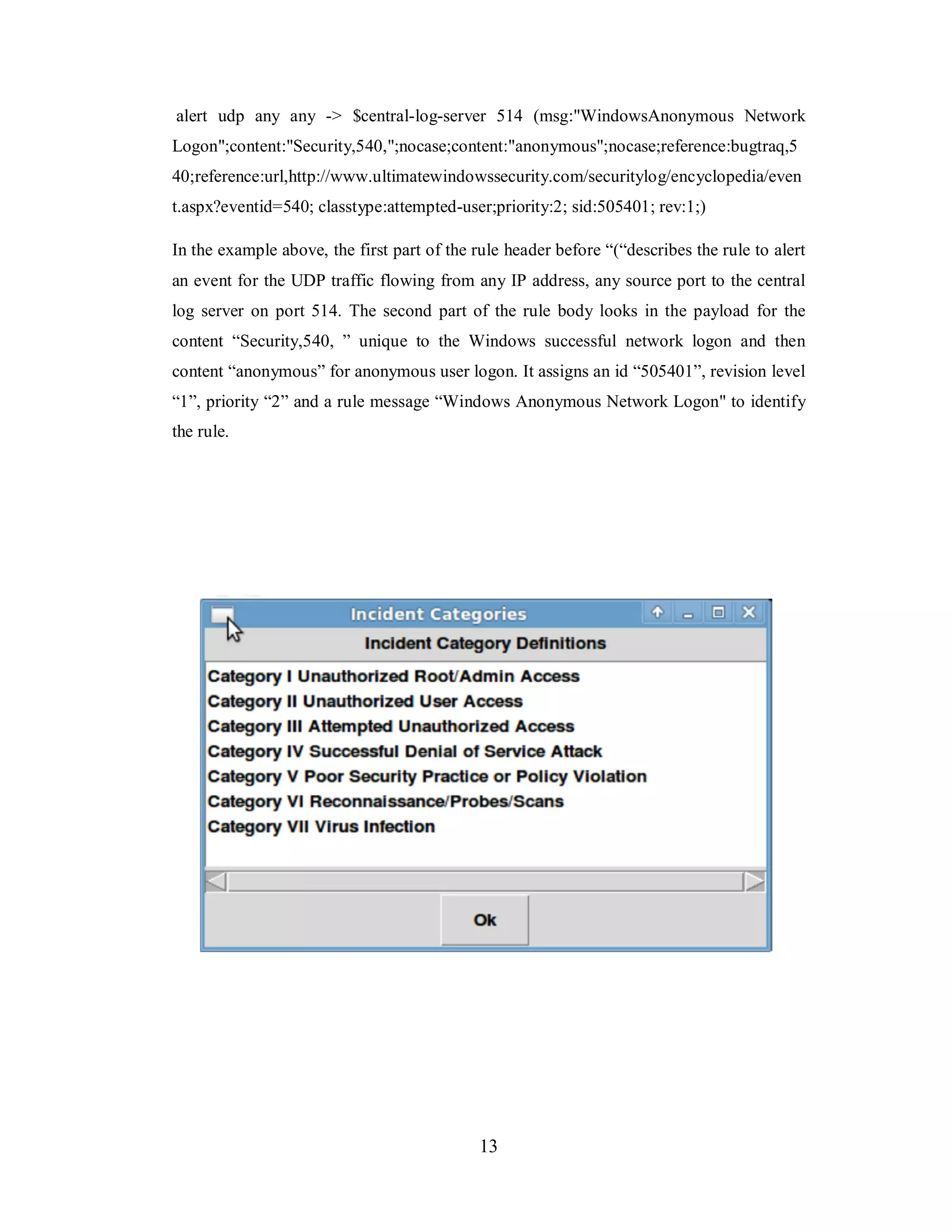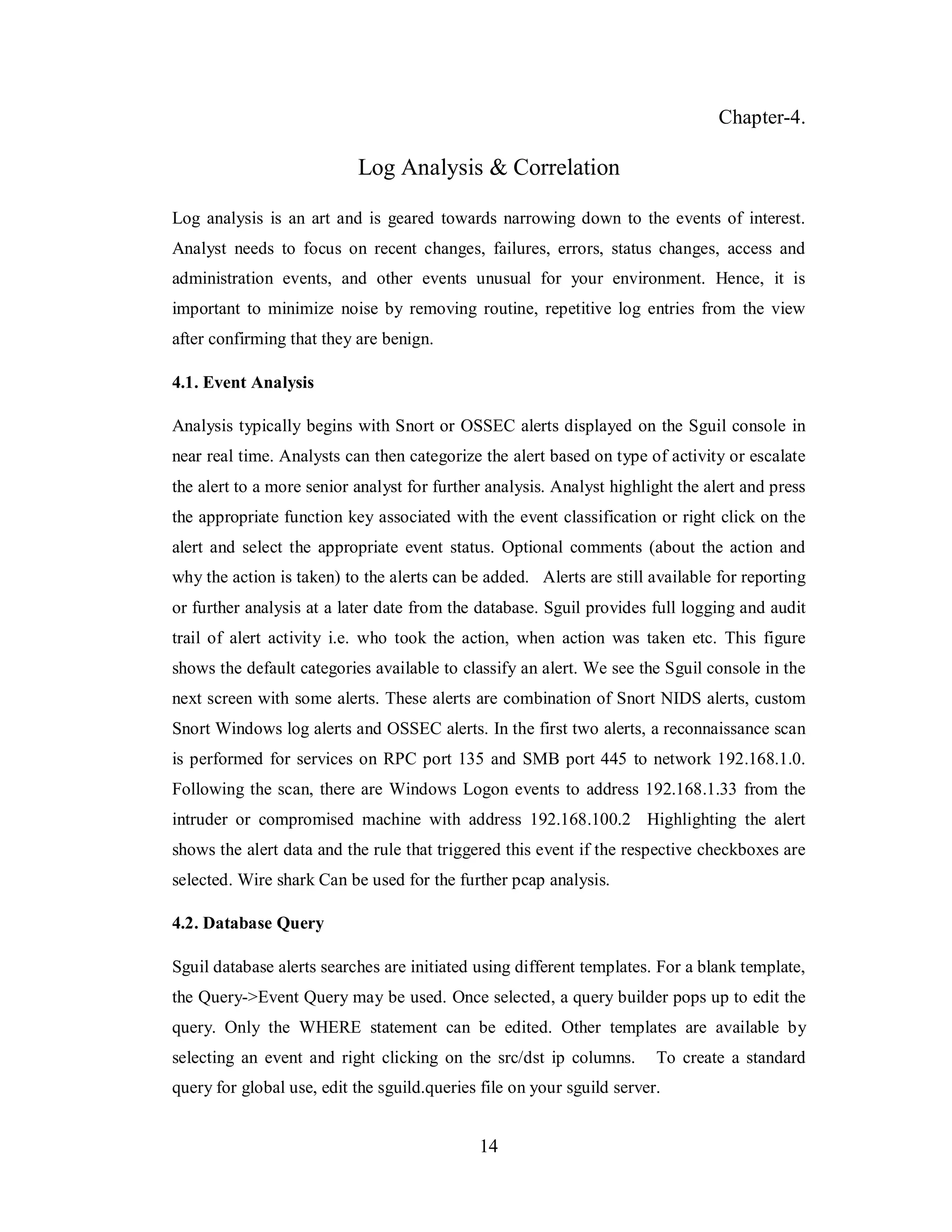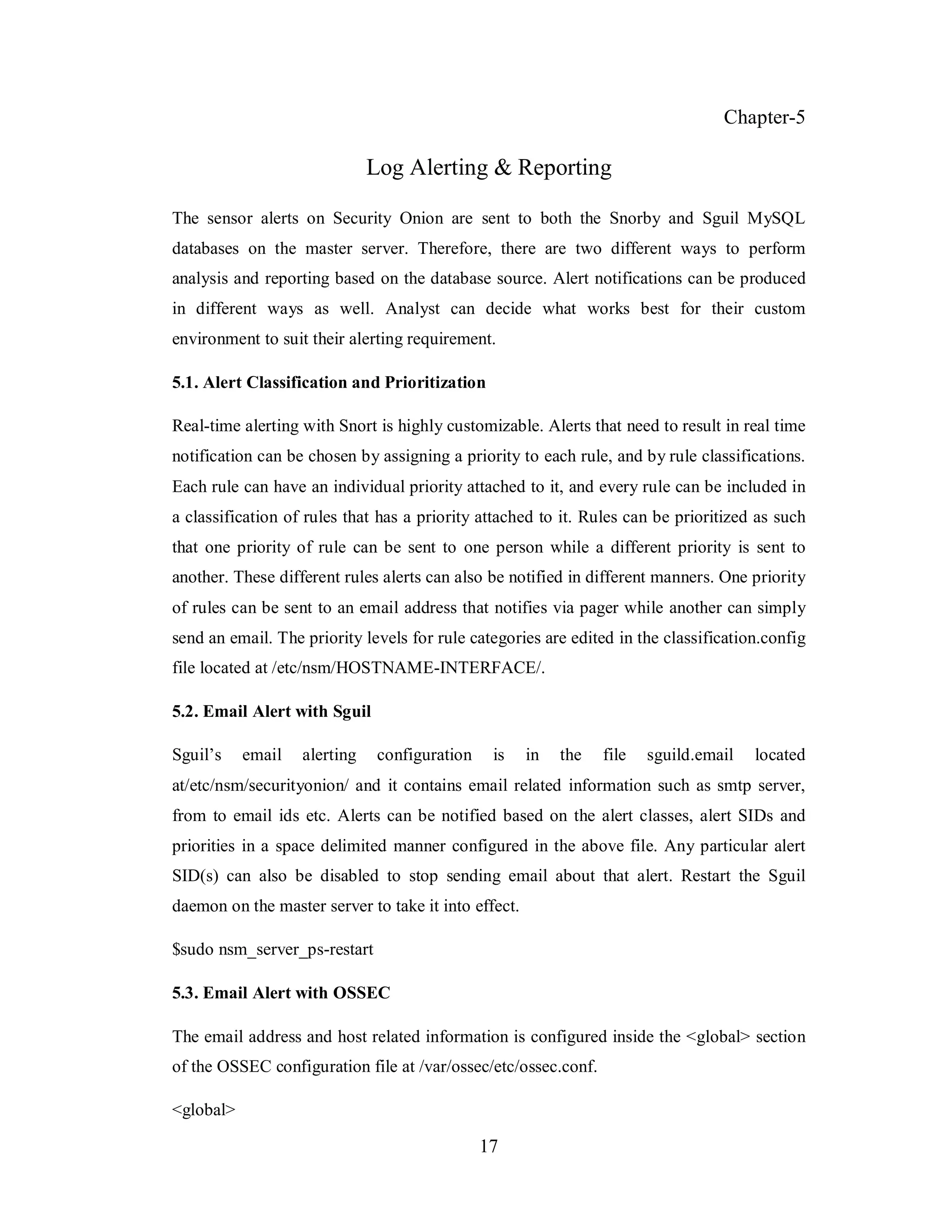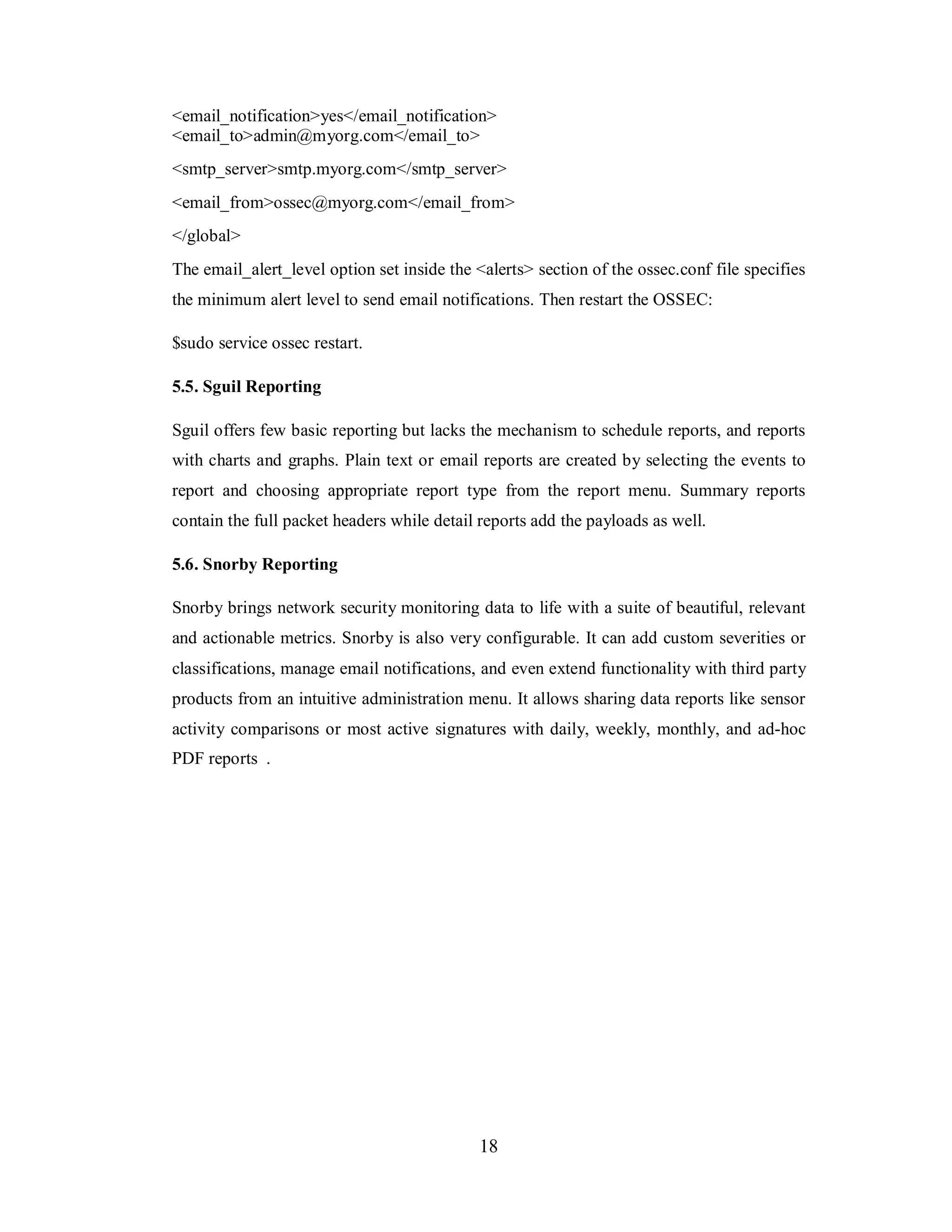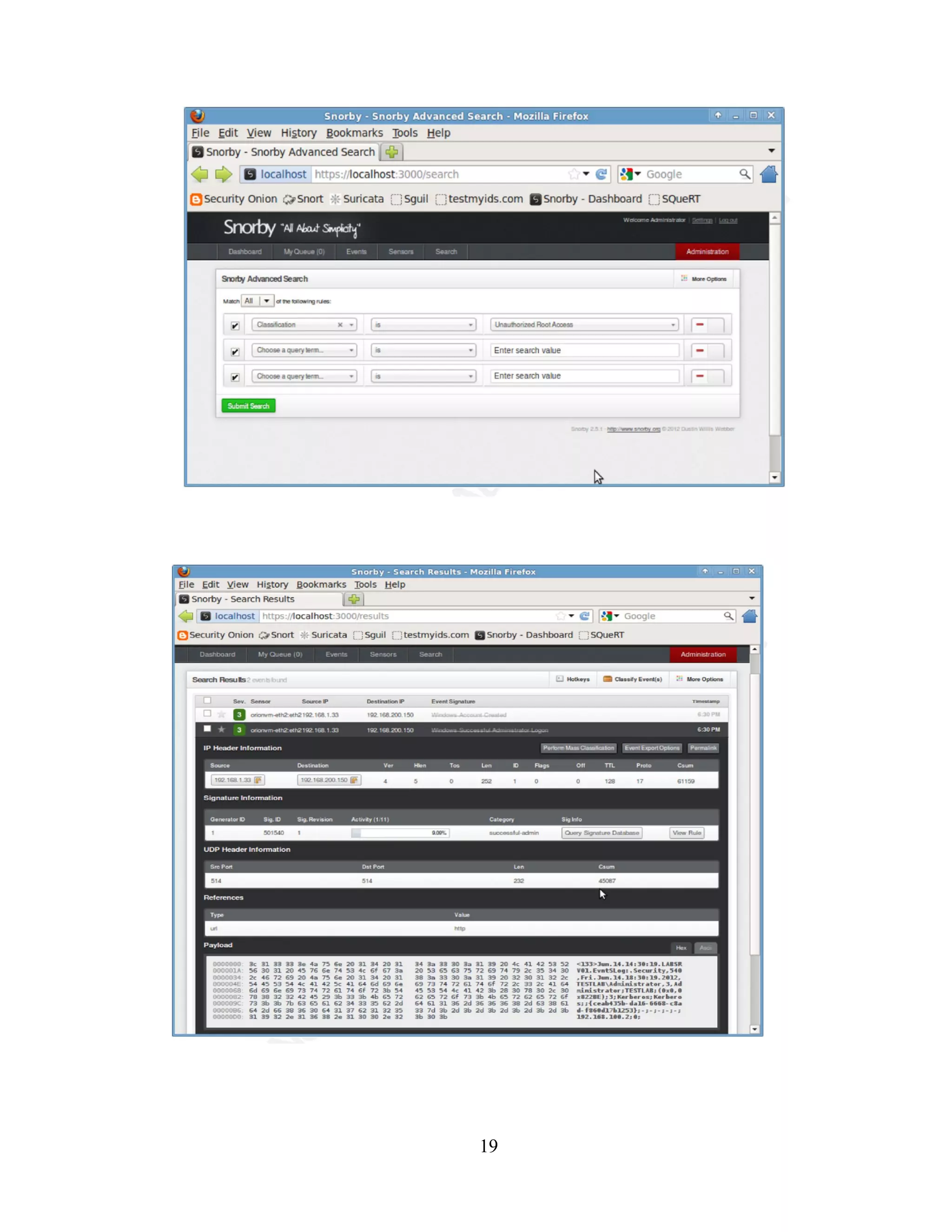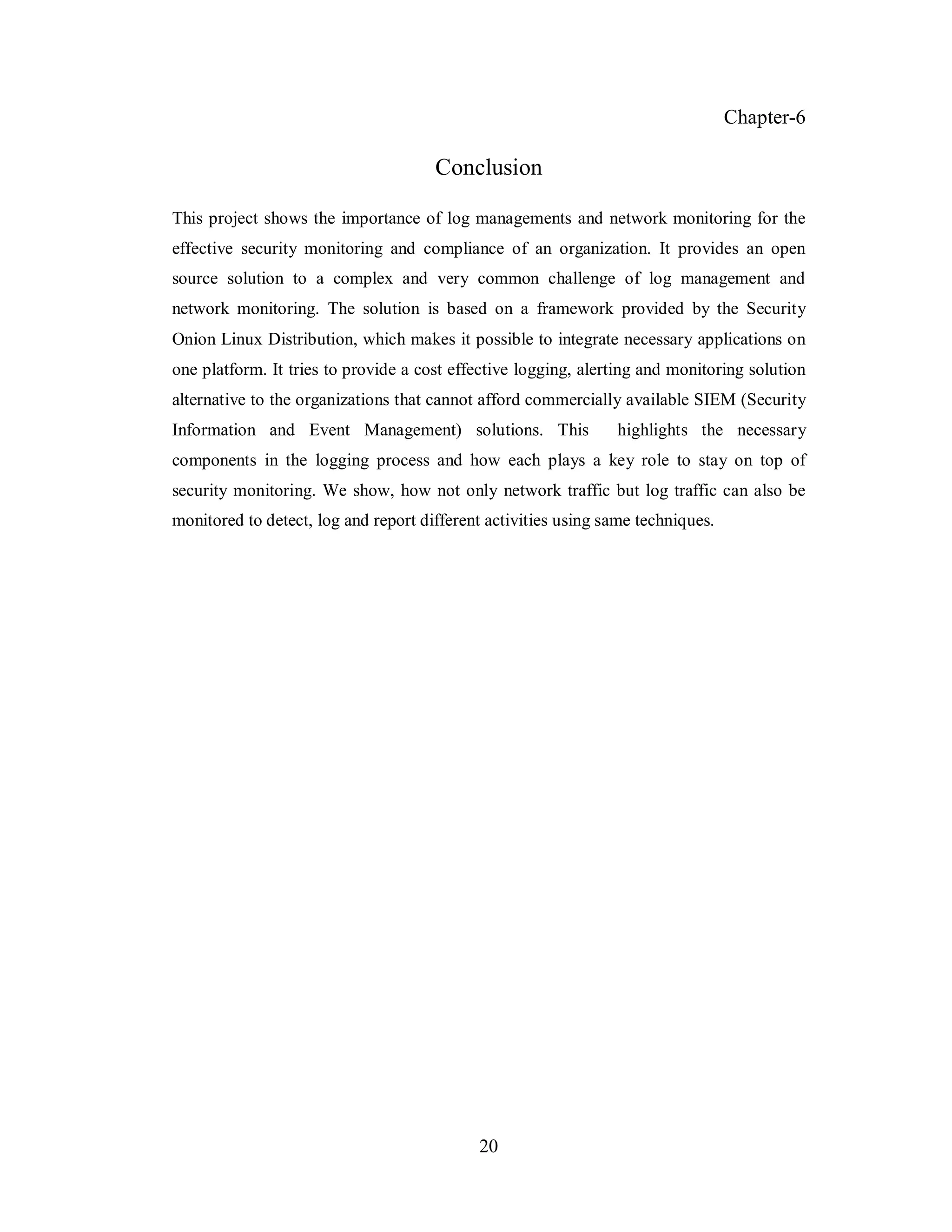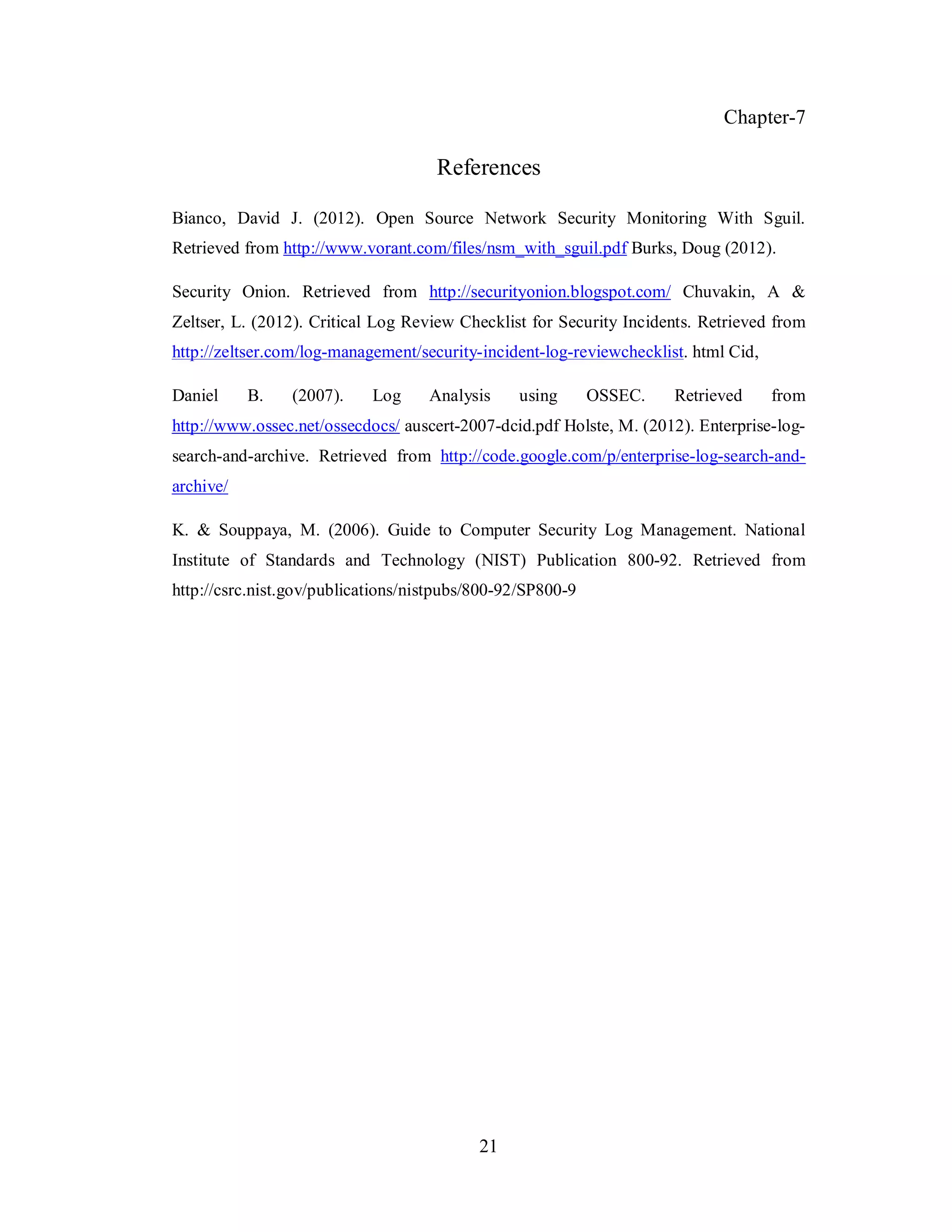This document discusses building an intrusion detection system that combines network-based and log-based detection. It proposes using the Security Onion distribution and its included tools like Snort, Sguil, Squert and OSSEC. It describes configuring Security Onion sensors to monitor network traffic and logs, storing alerts in databases, and using the management consoles to analyze alerts. The goal is to create a comprehensive security monitoring platform through centralized log management and correlation of network and host-based events.
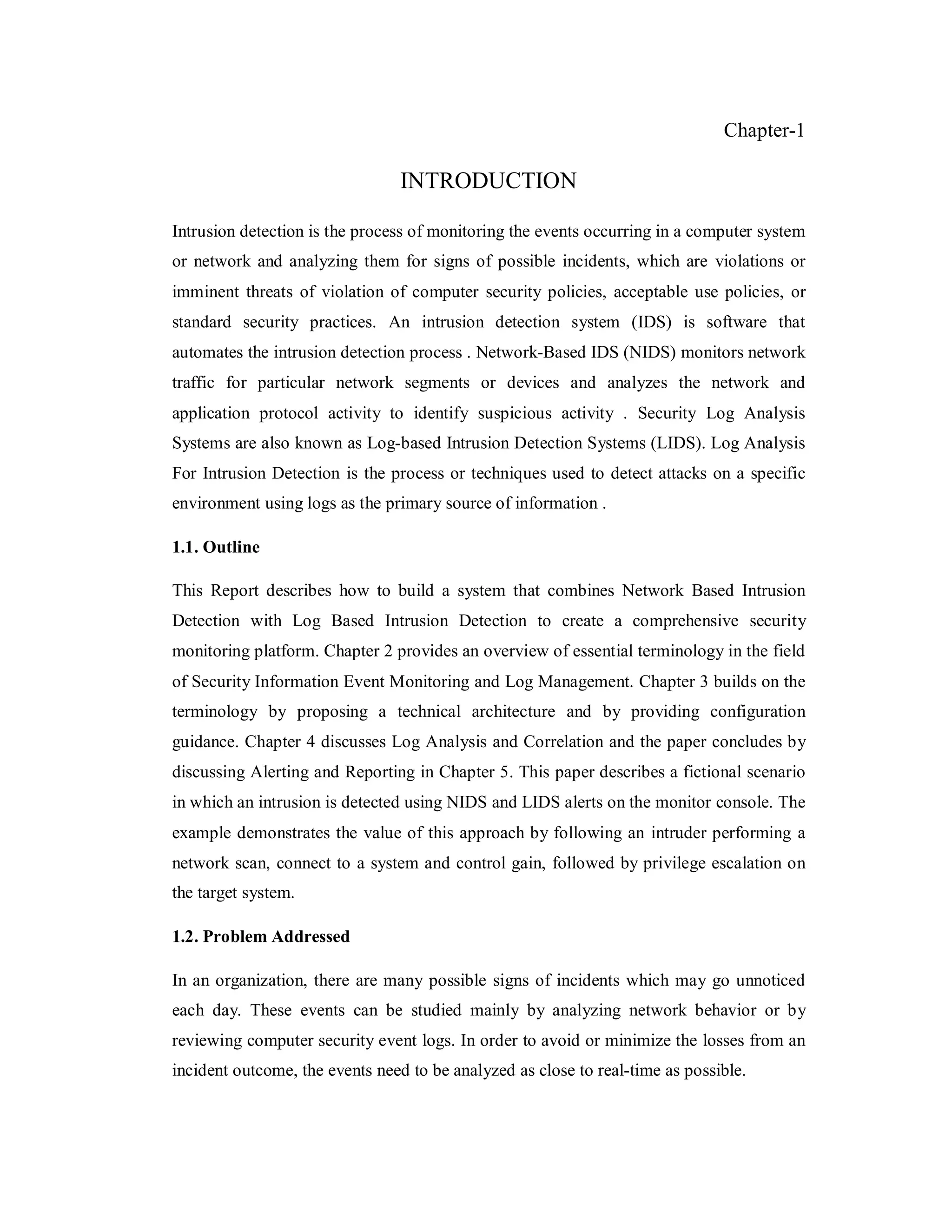

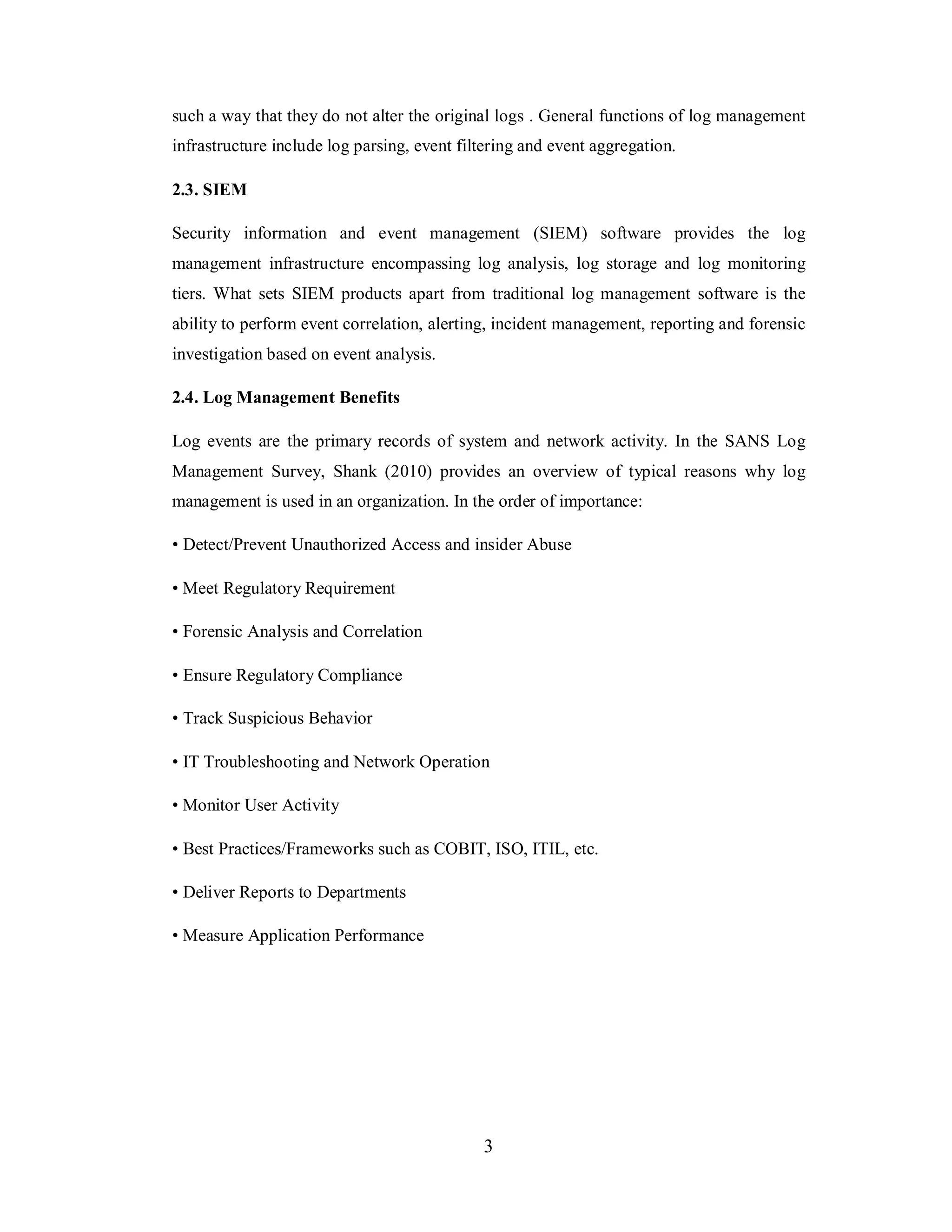

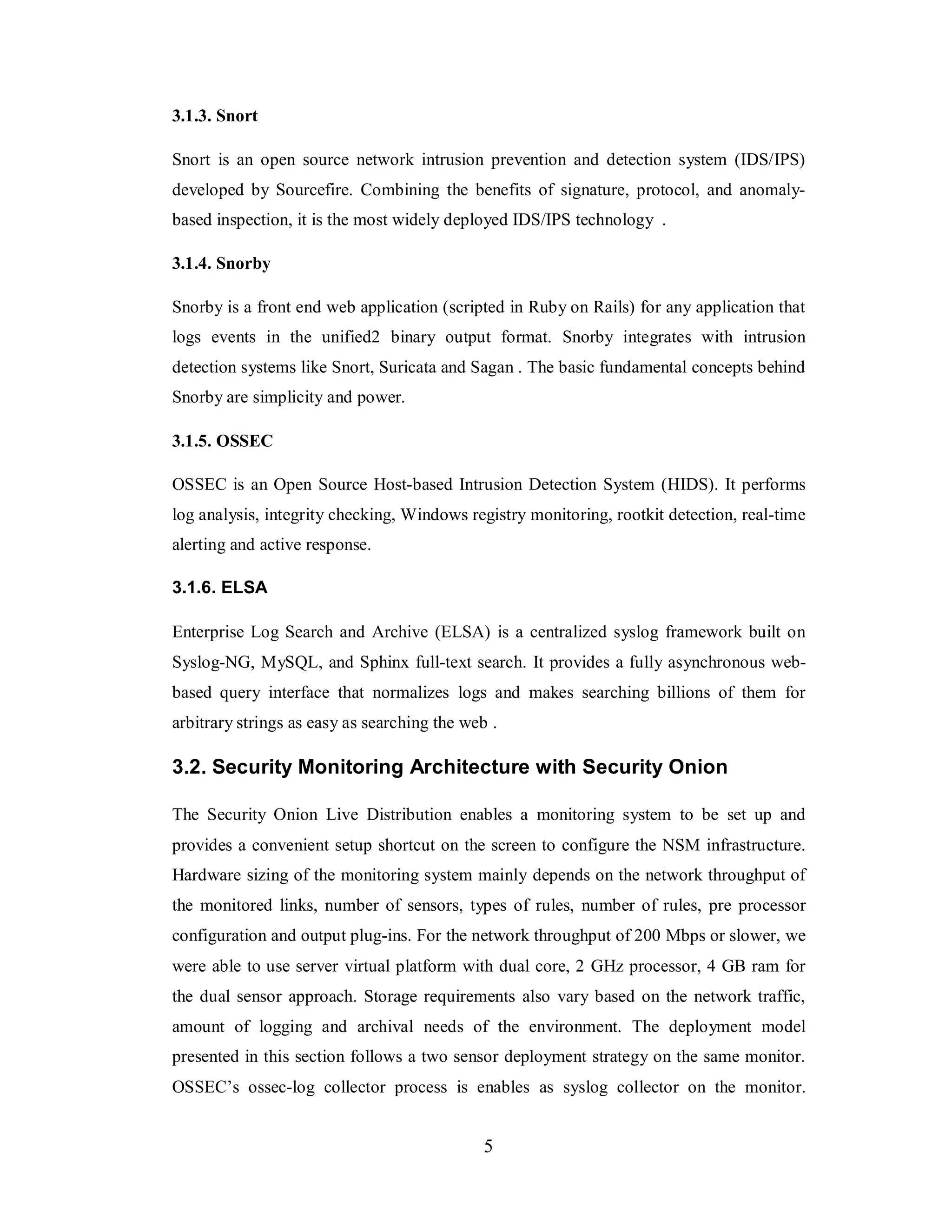

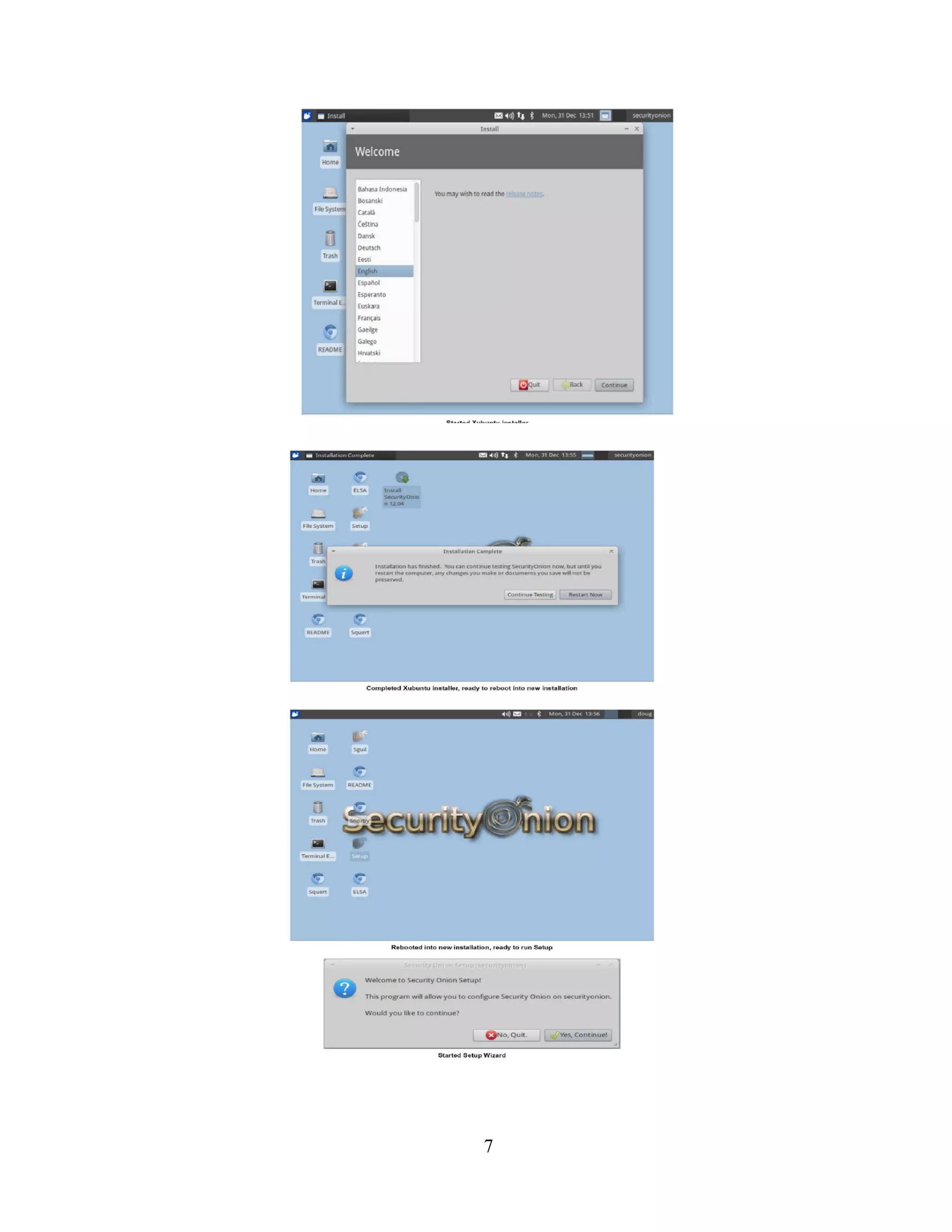

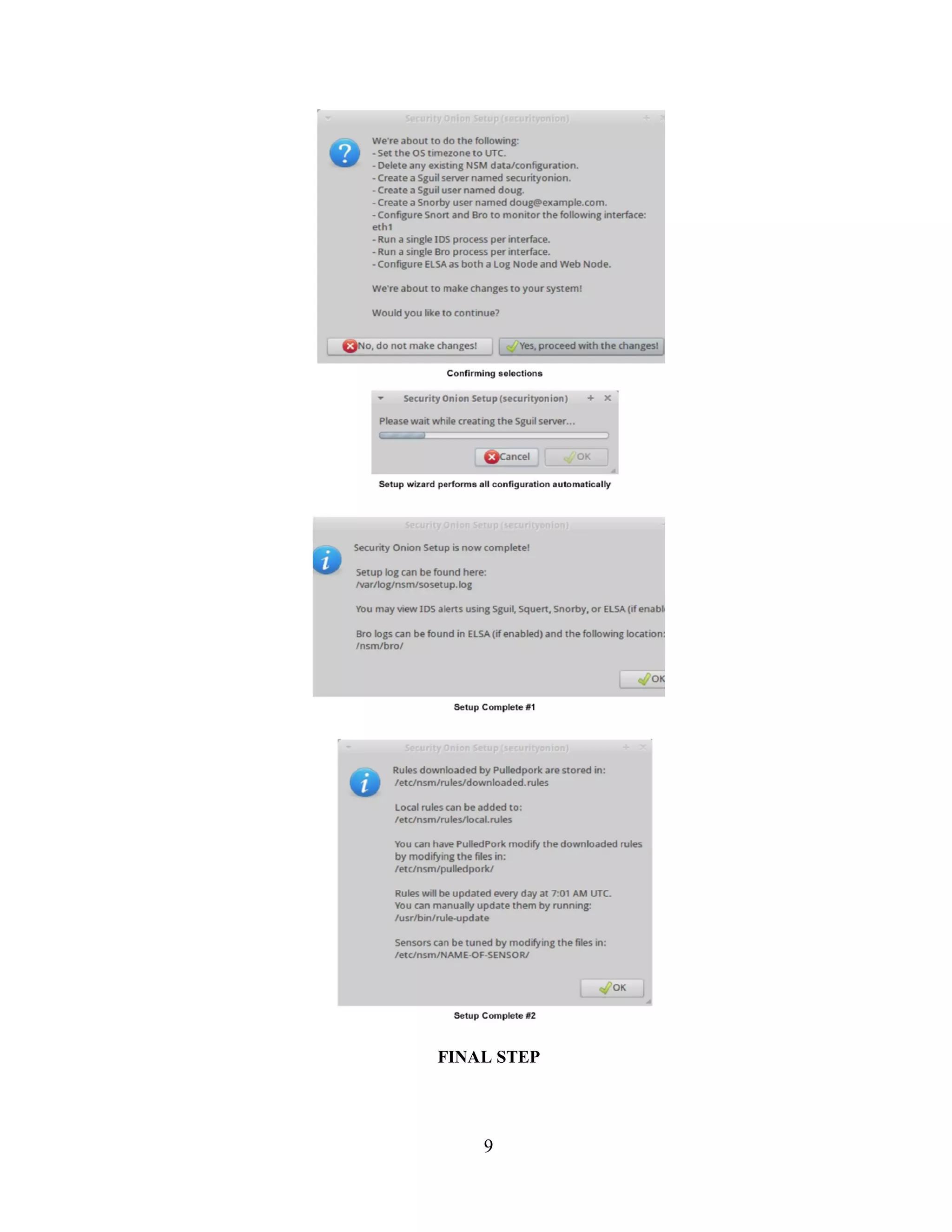
![3.4.1. Configuring OSSEC as Log Collector
OSSEC HIDS agent monitors host activities based on the rules defined for anomalous
event such as rootkit detection, integrity checking etc. These agents can also forward the
logged events or intrusion activities to the OSSEC management system. In this section,
OSSEC is configured on the SO monitor as a log collector to receive the logs from other
hosts. OSSEC remote configuration option makes the OSSEC agent run as a management
system that listens for agent traffic on the specified port.
3.4.2. Configuring NIDS Sguil/Snort Sensor
Snort is configured to monitor network traffic in the NIDS mode using switch spanning
port in this section. Custom Snort configuration is created for this interface in the file
located
under
respective
interface
folder
at
/etc/nsm/HOSTNAME-
INTERFACE1/snort.conf. Network variables, dynamic loaded libraries and pre
processors are configured to match the custom environment in the Snort configuration
file. Global Snort custom rules and rule classifications are added to local.rules and
classifications.config respectively located at /etc/nsm/rules/. Specific sensor custom rules
are added to respective sensor /etc/nsm/HOSTNAME-INTERFACE1/rules/ local.rules
rule
configuration.
Custom
classifications
are
defined
to
the
config
file
/etc/nsm/HOSTNAME-INTERFACE1/classifications.config. Sensor data is collected into
the directory /nsm/sensor_data/HOSTNAME-NIC1 .
3.4.3. Configuring Sguil Server
The Sguil database is created when NSM setup wizard is first run. Sguil configuration file
/etc/sguild/server.conf allows customization of the Sguil database and other environment
settings to suit the custom environment .The DAYSTOKEEP variable in the
configuration file /etc/nsm/securityonion.conf allows setting a retention period for the
alerts in the Sguil database. The NSM infrastructure service is started with the nsm script
provided on Security Onion.
user@orionvm:~$ sudo service nsm start
Starting: securityonion
* starting: sguil server [ OK ]
10](https://image.slidesharecdn.com/securityonionreport-131229091014-phpapp02/75/Report-Study-and-Implementation-of-Advance-Intrusion-Detection-and-Prevention-System-Based-on-Security-Onion-10-2048.jpg)
![Starting: orionvm-eth0
* starting: pcap_agent (sguil) [ OK ]
* starting: sancp_agent (sguil) [ OK ]
* starting: snort_agent (sguil) [ OK ]
* starting: snort (alert data) [ OK ]
* starting: barnyard2 (spooler, unified2 format) [ OK ]
* starting: sancp (session data) [ OK ]
* starting: pads (asset info) [ OK ]
* starting: pads_agent (sguil) [ OK ]
* starting: daemonlogger (full packet data) [ OK ]
* starting: argus [ OK ]
* starting: httpry [ OK ]
* starting: httpry_agent (sguil) [ OK ]
Starting: orionvm-eth1
* starting: pcap_agent (sguil) [ OK ]
* starting: sancp_agent (sguil) [ OK ]
* starting: snort_agent (sguil) [ OK ]
* starting: snort (alert data) [ OK ]
11](https://image.slidesharecdn.com/securityonionreport-131229091014-phpapp02/75/Report-Study-and-Implementation-of-Advance-Intrusion-Detection-and-Prevention-System-Based-on-Security-Onion-11-2048.jpg)
![* starting: barnyard2 (spooler, unified2 format) [ OK ]
* starting: sancp (session data) [ OK ]
* starting: pads (asset info) [ OK ]
* starting: pads_agent (sguil) [ OK ]
* starting: daemonlogger (full packet data) [ OK ]
* starting: argus [ OK ]
* starting: httpry [ OK ]
* starting: httpry_agent (sguil) [ OK ]
Starting: HIDS
* starting: ossec_agent (sguil) [ OK ]
After all services are started, the Sguil client can be launched. Sguil then allows selecting
which networks to monitor (eth0, eth1 and ossec). Clicking the Select All button shows
alerts from all sensors in the Sguil client.
3.5. Rules
Snort and OSSEC have a large number of rule sets available to choose from. Large
numbers of anomalies are detected right from the start using these rulesets. These rulesets
needs to be tuned to reduce the number of false positives. NIDS sensor works with Snort
rules to alert on a network event of interest. Writing rules becomes most important and
arguably most difficult part of the network security monitoring.
3.5.1. Snort Rule
Snort rules are powerful, flexible and relatively easy to write. All Snort rules follow a
very simple format and define what Snort should watch for as it inspects packet header,
payload or both. Snort rules are divided into two logical sections, the rule header and the
rule body. The optional rule body follows the rule header and is surrounded by
parentheses. Snort rules based on content inspection look for raw text, hex data
("!9090!"), or a mix of both. That makes it easy to write a rule to look for the known
patterns and detect a log based event. Here is a rule writing example to alert for a
Windows security log event id 540 associated with anonymous logon.
12](https://image.slidesharecdn.com/securityonionreport-131229091014-phpapp02/75/Report-Study-and-Implementation-of-Advance-Intrusion-Detection-and-Prevention-System-Based-on-Security-Onion-12-2048.jpg)
